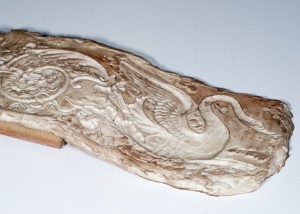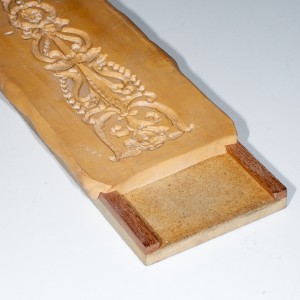Taking impressions for casting
 i. One’s natural inclination, since the stuff is ridiculously expensive, is to be really mean with it. This produces seriously floppy moulds, very difficult if not impossible to work with.
i. One’s natural inclination, since the stuff is ridiculously expensive, is to be really mean with it. This produces seriously floppy moulds, very difficult if not impossible to work with.
ii. Even when a lot of the stuff has been used, the back of the mould is certainly not flat. nor is it in any way parallel to the base surface; also often there’s not much of that base surface; you need a ‘datum’ surface to work from.
iii. Most old bits of brassware, especially the more ornate stuff is extremely dirty, often enough to obscure even the fact that once it was gilded!! The dental silicone doesn’t appear to harm any polished or painted surfaces (a light rub afterwards removes all traces of the release agent) but it does have a remarkable affinity for muck, a lot of which is found stuck to the rubber mould. So, here are my solutions to achieving a better result whereby I can usually produce first generation waxes directly from the silicone mould. This is more faithful to the original and cheaper for you than anything other than detaching an original and sending it to me for mould-making.
Firstly, see if you can buy out of date silicone rubber; it may be cheaper, and will certainly set slower which is bad for a dentist but good for us; I’ve used 3-year out of date stuff which has given me 10 minutes instead of 1 minute.
-
 Clean the original; a toothbrush alone works wonders; dry or slightly moist, not wet. I use an electric toothbrush. Wipe with a lint-free cloth, you don’t want bits of fibres stuck in there either. Judicious use of a wooden toothpick or cocktail stick is good too. You don’t copy the obvious bad points of an old instrument, do you? so equally you don’t need to faithfully copy last centuries’ dirt.
Clean the original; a toothbrush alone works wonders; dry or slightly moist, not wet. I use an electric toothbrush. Wipe with a lint-free cloth, you don’t want bits of fibres stuck in there either. Judicious use of a wooden toothpick or cocktail stick is good too. You don’t copy the obvious bad points of an old instrument, do you? so equally you don’t need to faithfully copy last centuries’ dirt.
-
Make a backing board from 6mm MDF rather larger than the object. To the long sides glue rails of wood nicely finished to stand proud by 2mm more than the depth of the brassware you want to copy, dovetailed to hold the set rubber firmly against the board. Seal and polish the inner surfaces. I must thank Detmar Hungerberg for thinking of this trick!
-
Mix up as small an amount of the rubber as you think can be made to cover the object, and press it firmly around the whole thing; time it to find out how long you have before it goes off. When it’s set, peel it off and have a good look at the mould, and the master. You will find the last bits of loose dirt will be imbedded in the rubber, and the master (and whatever it is fixed to) will have come to no harm. (This, done on something less important to prove the point first, will get you brownie points from owners and museum curators.)
-
Now mix up an amount you think will be needed for the job; press it onto the object from centre out, follow it rapidly with the prepared board, which is used to apply reasonable pressure to the whole thing. Keeping the board parallel to the base surface, hold it until the rubber has set.
- The rubber will possibly have flowed in part into any gaps between metal and case-work; some may remain on the impression, some may be left behind. Do remove the bits left attached to the instrument but please leave the impression alone; I cut away some of this but not all; it helps to see exactly how thick the original was. If this is done well. I can inject wax directly into the mould through a hole in a sheet of 6mm aluminium sheet, which takes the place of the structure to which the master was attached, with very little in the way of preparation and not much work on the waxes afterwards. There – I’ve given away trade secrets so you can all do it!! If much remains to be done however, I have to make a mould from a resulting first generation casting, or I have to cast a resin master into the mould and do a lot of expensive work on that before making a mould .So it really is worth taking trouble with that expensive dental rubber. Incidentally, don’t even think about using ‘Alginate’; it is a very cheap pink powder which you mix with water; it sets quickly too but remains dimensionally stable only for as long as it is wet, and for hours only even so. My dentist used it to cast some copies of the bone ‘knocks’ on the ends of the Sutton Hoo bow (which had to be kept wet anyway) but he had to be quick; I’m glad my teeth weren’t hurting while he did it…….

